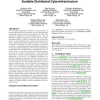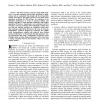133
click to vote
BMCBI
2008
15 years 13 days ago
2008
Background: Evolutionary conservation of RNA secondary structure is a typical feature of many functional non-coding RNAs. Since almost all of the available methods used for predic...
BMCBI
2008
15 years 13 days ago
2008
Background: The ability to access, search and analyse secondary structures of a large set of known RNA molecules is very important for deriving improved RNA energy models, for eva...
100
click to vote
BMCBI
2008
15 years 13 days ago
2008
Background: Depending on their specific structures, noncoding RNAs (ncRNAs) play important roles in many biological processes. Interest in developing new topological indices based...
HPDC
2010
IEEE
15 years 1 months ago
2010
IEEE
The increasing significance of RNAs in transcriptional or post-transcriptional gene regulation processes has generated considerable interest towards the prediction of RNA folding ...
106
click to vote
CIBCB
2009
IEEE
15 years 1 months ago
2009
IEEE
Abstract-- The RNA secondary structure design (SSD) problem is a recently emerging research topic motivated by applications such as customized drug design and the self-assembly of ...
113
click to vote
BIOCOMP
2009
15 years 1 months ago
2009
The accurate computational prediction of RNA secondary structures is a difficult task, but an important one, since RNA structure is usually more evolutionarily conserved than prima...
107
click to vote
CSB
2004
IEEE
15 years 4 months ago
2004
IEEE
Motivation: Since the whole genome sequences for many species are currently available, computational predictions of RNA secondary structures and computational identifications of t...
WABI
2004
Springer
15 years 5 months ago
2004
Springer
We describe an algorithm for comparing two RNA secondary structures coded in the form of trees that introduces two novel operations, called node fusion and edge fusion, besides the...
116
click to vote
SPIRE
2005
Springer
15 years 5 months ago
2005
Springer
We introduce the notion of conservative edit distance and mapping between two RNA stem-loops. We show that unlike the general edit distance between RNA secondary structures, the co...
111
click to vote
CSB
2005
IEEE
15 years 6 months ago
2005
IEEE
Searching genomes for RNA secondary structure with computational methods has become an important approach to the annotation of non-coding RNAs. However, due to the lack of effici...


